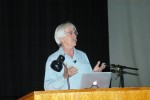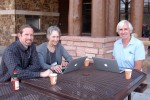In September 2012, we participated in the 2012 All Scientists Meeting (ASM) of the Long Term Ecological Research (LTER) Network in Estes Park, Colorado, to make the case for integrating more anthropologists into the study of ecosystems. During the ASM’s initial plenary, the presence of “embedded” anthropologists was announced to all, and we were invited to stand and identify ourselves for the audience. From then on we spent several days immersing ourselves in the activities of the LTER network and engaging with its researchers, a group previously unknown to many of us. We worked to overcome apprehensions (“why are anthropologists studying us?”), identify areas where our expertise might be useful (“what can anthropologists contribute to ecological research?”), and left with some ideas about the opportunities and challenges for integrating anthropologists into the LTER network. Anthropologists at the ASM
Anthropologists have been involved in research at a number of the LTER sites—e.g., Ted Gragson (CWT), Laura Ogden (FCE), Charles Redman (CAP)—and have written about the integration of social science in the LTER network (Redman et al. 2004. Integrating Social Science into the Long-Term Ecological Research (LTER) Network, Ecosystems), but the theme of this year’s ASM meeting—the Anthropocene—offered a unique opportunity to make the case for greater involvement of anthropologists in LTER projects.
And so, with the support of the Cultural Anthropology program at the National Science Foundation (NSF), several cultural anthropologists played prominent roles in the ASM program. Steve Lansing gave a keynote lecture about his research on complex adaptive (farming) systems in Bali (http://tinyurl.com/8aq8t9r), while Michael Agar and Michael Paolisso organized two workshops to identify bridges between ecological anthropology and LTER projects to strengthen research into ecological and human dimension interactions at multiple geographic and time scales.
The two workshops showcased our research, which represented a wide range of theoretical and methodological approaches within ecological anthropology, but all underscored the relevance of anthropological approaches for study of complex social-ecological systems in the Anthropocene. In addition, we participated in workshops, visited the poster sessions, and made connections with LTER researchers. Most researchers at our session were already studying the human dimensions of ecosystems, which represents an existing "bridge" to integrating anthropology.
There is a growing recognition among ecologists of the need to grapple with the human impacts on ecosystems and that previous emphasis on studying isolated and protected reserves to understand ecosystems may be necessary but not sufficient. This is evidenced by the theme of this year’s ASM meeting and the increasing impact of climate change on ecosystems in the LTER sites.
However, there are few ecological models that satisfactorily incorporate human complexity. Ecologists may study ecosystem processes at the micro-scale and then jump to the global macro-scale, e.g., measuring the impact of global warming on these processes, thus skipping the local, regional, and national scales at which human activities more directly affect ecosystem processes in myriad ways. This offers opportunities for anthropologists who study complex social-ecological systems using a holistic approach and making linkages across these spatiotemporal scales.
Moreover, anthropologists are no strangers to long-term research as many are involved in ethnographic research at a single site over many decades. Thus, anthropologists can make significant conceptual contributions to LTER projects.
Opportunities
What makes participation in research in LTER sites attractive is that anthropologists living close to an LTER site could do research in their own backyard. There are currently 26 sites across the U.S., so there are plenty of opportunities. In addition, it offers the possibility of funding sources other than the Cultural Anthropology program at NSF.
However, funding processes are complicated and opportunities may be more limited (than they should be). For example, funding restrictions within NSF may limit the integration of social and ecological research. Furthermore, guidelines or processes for funding social science research within and across LTER projects vary, making it difficult to sustain long-term involvement of anthropologists (and other social scientists), which in turn limits comparative analysis of our contributions. This means anthropologists may have to find other sources of funding to support their research at LTER sites.
However, there may be many more opportunities for enterprising graduate students in anthropology to join an LTER team. The advantage for graduate students is that LTER sites have extensive data and an established infrastructure, which removes some of the challenges of finding a new field site and provides ample opportunity to collaborate with other LTER researchers.
The research model of the LTER network—long-term projects, cross-site linkages, and consistent funding—also offers unique opportunities for anthropologists to rethink ways of doing research in unprecedented ways. Whereas long-term ethnographic research often depends on the commitment of individual researchers, research at LTER sites is institutionalized. What comprehensive, long-term, high frequency data on social systems could be collected across multiple sites to advance our understanding of the dynamic processes in coupled human and natural systems? That is an exciting question to ponder and we feel worthy of pursuing in collaboration with the LTER Network.
Challenges
While there are social science activities at almost all LTER sites and the network has a long history of social science engagement, it is often on an ad hoc and inconsistent basis and contingent on funding availability. The greatest challenge in integrating anthropological research in LTER projects may be a general problem of interdisciplinary research. This is manifested in different ways, including the lack of fit among conceptual models, theories, methods, scope, and units of analysis in ecology and anthropology.
Anthropologists’ primary goal has been describing and explaining cross-cultural variation across human societies using ethnographic approaches. These ethnographic research strategies are typically not well understood by ecologists, whose use of more standardized scientific protocols leads them to question the value and validity of anthropological contributions.
Of course, there are many ecologists and anthropologists who have successfully collaborated in interdisciplinary studies of complex social-ecological systems, for example the South Turkana Ecosystem Project in Kenya, but the number of transdisciplinary studies in which research transcends the disciplines remains quite limited and is insufficient to develop broadly applicable "lessons learned."
Conclusion
If we want to make the case for integrating more anthropologists in the study of ecosystems, we should at least become familiar with what ecologists think of our research (and us). The audience at our workshops consisted primarily of fellow anthropologists, ecology graduate students, and a few Principal Investigators of LTER sites, which indicates that among the higher organizational levels of the LTER network and the next generation of ecologists there is an interest in anthropological approaches to study anthromes in the Anthropocene.
However, there still may be some resistance to the integration of social sciences in ecosystem research as well as stereotypes of what anthropologists do and can contribute. A hopeful sign was that Lansing’s keynote was well-received by the ecologists in the audience, who were excited to see how topics that interested them were interwoven with topics more familiar to anthropologists, including religion, social relations, economic development, and governance. It may not be an exaggeration to say that for an hour or so there were no disciplinary differences between the social and natural scientists in the audience, but rather shared and genuine excitement as we witnessed how ecological and socio-cultural complexity were integrated by theories and approaches that helped us transcend disciplinary boundaries.
In the end, one keynote and two workshops are only a first step in making the case for what anthropology can contribute to LTER. It was, however, a critical first step, and one warranting follow up dialogue and engagement. For us, it was a very positive experience and we appreciate the opportunity to participate in the LTER ASMs. We are open to further collaboration with ecologists, believe we can offer valuable insights on the human dimensions of ecological research, and are sure we would learn much from collaboration with ecologists and LTER.
By Mark Moritz (Ohio State University), Michael Paolisso (University of Maryland), Courtney Carothers (University of Alaska-Fairbanks), Sean Downey (University of Maryland), Kathleen Galvin (Colorado State University), Drew Gerkey (National Socio-Environmental Synthesis Center (SESYNC)), J. Stephen Lansing (University of Arizona), Terrence McCabe (University of Colorado), Amber Wutich (Arizona State University), Rebecca Zarger (University of South Florida)

 Enlarge this image
Enlarge this image

